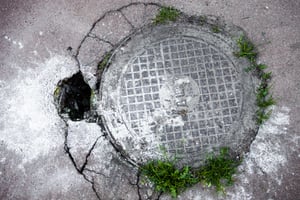Sewers are designed to endure a lot: collecting, transporting, sorting and processing human waste, debris, normal flow and, in some cases, rainwater and runoff. But they can only withstand so much over a period of time before they begin to break down. General wear-and-tear is one of the leading causes of sewer damage, but there are other common contributors, too.
Improper Sewer Installation and Maintenance
.jpg?width=304&name=shutterstock_641657908%20(1).jpg)
An improperly installed or designed sewer line can lead to a number of issues, including sags, breaks, open joints and offset joints. Damage can also occur as new laterals are added to an existing line.
Without proactive maintenance, wastewater professionals are constantly operating reactively — increasing room for catastrophes and unexpected costs. Every line should be regularly inspected and cleaned correctly to avoid trouble.
“Sometimes wastewater teams select the wrong tools to clean or remove obstacles which can actually damage the pipe more,” says Mike Russin, general manager of WinCan. “Or the high-pressure water they use can disturb the pipe or put more stress on the joints, so it’s important to be intentional with maintenance practices.”
Sewer Age
Like everything else, pipes age. They begin to crack and leak with time, sometimes from natural processes like corrosion, sediment build-up or surrounding soil movement, but other times from human impact.
While regular inspections and maintenance can help operators identify a problem before a bigger one occurs, many causes of sewer damage are unavoidable and all pipes eventually reach their life span and require full rehabilitation or replacement.
Tree Roots
Tree roots are a common cause of sewer damage. Roots are drawn to the moisture and nutrients in wastewater and as they grow down toward the sewer pipes, they can be strong enough to enter the pipe through loose joints or cracks. Once they’ve infiltrated a sewer line, they can cause destruction quickly, creating blockages and turning small cracks into big ones.

“This is why inspections are crucial,” Russin says. “If you can find the roots early and treat them or have them removed, you won’t have to replace the whole sewer line — you may only have to fix a joint or section of pipe. But if you don’t televise the line, you aren’t going to find it in time.”
Sewer Blockages and Clogs
Blockages and clogs can cause long-term damage to a pipe and often occur as the result of human error. These typically take place because something that isn’t supposed to be flushed down the toilet or washed down the sink has been, whether it’s grease from cooking, excessive amounts of toilet paper, wipes, or a small toy. The blockage restricts proper water flow and can lead to utility disruptions, backups and overflows.
Minimizing Sewer Damage
Some of these issues, like blockages, clogs and tree roots can be minimized with some effort and education. Many wastewater departments work to keep their communities informed about what can be flushed down the toilet and washed down the sink, as well as the risk of damage if that advice is ignored. Reducing the threat of tree roots typically comes down to routine inspections and identifying their intrusion before serious harm ensues. Rock salt or copper sulfate can be used to kill tree roots, but fighting regrowth is often an ongoing battle.
On the other hand, there are some causes of sewer damage that are out of our control, including time.
“The American Society of Civil Engineers indicates that the nation's 500,000-plus miles of sewer lines are on average over thirty years old,” according to the Insurance Information Institute. “The increase in the number of homes connected to already aging sewage systems has also contributed to rapid increases in sanitary sewer backups, flooded basements and overflows.”
Regular sewer inspections are a crucial part of preventative maintenance — identifying issues so you can address them before more severe problems ensue. WinCan makes it easy to collect detailed, standards-compliant inspection data so you can better understand sewer condition and plan ahead. Request a free demo of WinCan VX today:





